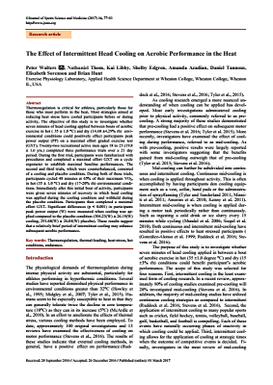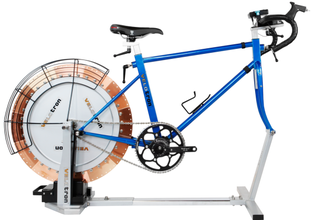|
Published study suggests brief and selective head cooling with WElkins SCS can enhance aerobic performance  Researchers at Wheaton College announced the publication of their athletic cooling study in the Journal of Sports Science and Medicine. Key findings included a considerable and statistically significant improvement in athlete performance (power output and time to volitional exhaustion) when head-neck cooling was used over a control condition. The athletic study compared WElkins head-neck cooling against a placebo (counter-balanced) in a short recovery window between bouts of aerobic exercise in hot (35C) conditions: athletes began with a 40-minute cycle at 65% maximal VO2, briefly recovered with active cooling or placebo, then concluded with a maximal effort graded exercise test (GXT). When athletes received active cooling during the brief recovery window, their performance on the subsequent GXT exhibited a considerable increase in peak aerobic power output and extended the time to volitional exhaustion by more than 30 seconds. See below for the Abstract and a link to the full article. AbstractThermoregulation is critical for athletes, particularly those for those who must perform in the heat. Most strategies aimed at reducing heat stress have cooled participants before or during activity. The objective of this study is to investigate whether seven minutes of head cooling applied between bouts of aerobic exercise in hot (35 ± 1.0 °C) and dry (14.68 ±4.29% rh) environmental conditions could positively effect participants peak power output (PP) on a maximal effort graded exercise test (GXT). Twenty-two recreational active men ages 18 to 23 (19.8 ± 1.6 yrs.) completed three performance trials over a 21 day period. During the first trial, participants were familiarized with procedures and completed a maximal effort GXT on a cycle ergometer to establish maximal baseline performances. The second and third trials, which were counterbalanced, consisted of a cooling and placebo condition.  Velotron Cycle Ergometer (Racermate) Velotron Cycle Ergometer (Racermate) During both of these trials, participants cycled 40 minutes at 65% of their maximum VO2, in hot (35 ± 1.0 °C) and dry (17-20% rh) environmental conditions. Immediately after this initial bout of activity, participants were given seven minutes of recovery in which head cooling was applied during the cooling condition and withheld during the placebo condition. Participants then completed a maximal effort GXT. Significant differences (p < 0.001) in participants peak power output (W) were measured when cooling was applied compared to the placebo condition (304.23(W) ± 26.19(W) cooling, 291.68(W) ± 26.04(W) placebo). These results suggest that a relatively brief period of intermittent cooling may enhance subsequent aerobic performance. Link to full article: Journal of Sports Science and Medicine (2017) 16, 77 - 83
Comments are closed.
|

 RSS Feed
RSS Feed
